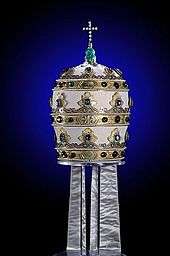Napoleon Tiara

The Napoleon Tiara was a papal tiara given to Pope Pius VII by Emperor Napoleon I in 1805.
The tiara, which was of traditional papal tiara design, was designed and manufactured by Henry August and Marie-Etienne Nitot of the House of Chaumet in Paris. Some of the jewels and decoration for this tiara came from earlier tiaras smashed and stolen by the troops of the French Directory in 1798. The great emerald stolen by Napoleon's troops, which had once been on the Tiara of Pope Julius II, was placed on the tiara in the monde.
Tiaras were traditionally in the region of 2 to 5 pounds (0.91 to 2.27 kg) in weight. The Napoleon Tiara, however, was made a massive 18 pounds (8.2 kg). In addition it was made too small to fit comfortably on a pope's head. It was speculated that both its weight and size were chosen to humiliate the pope, who could not wear such a tiara, or if he did, would risk serious neck injury. In the David painting of The Coronation of Napoleon, the tiara is held next to him by one of his aides; the emeralds are not in the painting.
In any case, neither Pius VII nor his successor wore it for reasons unconnected with its size and weight. They saw it as the product of Napoleon's theft, as it was made from past tiaras French troops had stolen, and Napoleon, who had driven Pius's predecessor into exile, had stolen the Vatican Archives and forced Pius against his will to preside over Napoleon's coronation. The tiara originally contained three inscriptions glorifying Napoleon. After the fall of Napoleon, Cardinal Ercole Consalvi, the Cardinal Secretary of State, ordered the removal of the inscriptions.
The Vatican later adjusted the size of the tiara to enable it to be worn. It was used as the coronation tiara for a number of popes, most notably Pope Pius IX on 21 June 1846.[1] It was last worn during the First Vatican Council in 1870.[2]
With the exception of the emerald in the monde, all the jewels were removed and replaced by replicas made of coloured glass on the orders of Pope Benedict XV. The jewels were then sold, with the money raised used to aid victims of the First World War.[3]
Notes
- ↑ The United States Catholic Magazine and Monthly Review 5: 454. 1846. Missing or empty
|title=(help) - ↑ de la Garde Grissell, Hartwell (January–June 1896). "Notes and Queries". A Medium of Intercommunication for Literary Men, General Readers, Etc. Eighth Series (London) 9: 9, 10.
- ↑ Milwaukee Journal Sentinel. February 3, 2006. Missing or empty
|title=(help)
